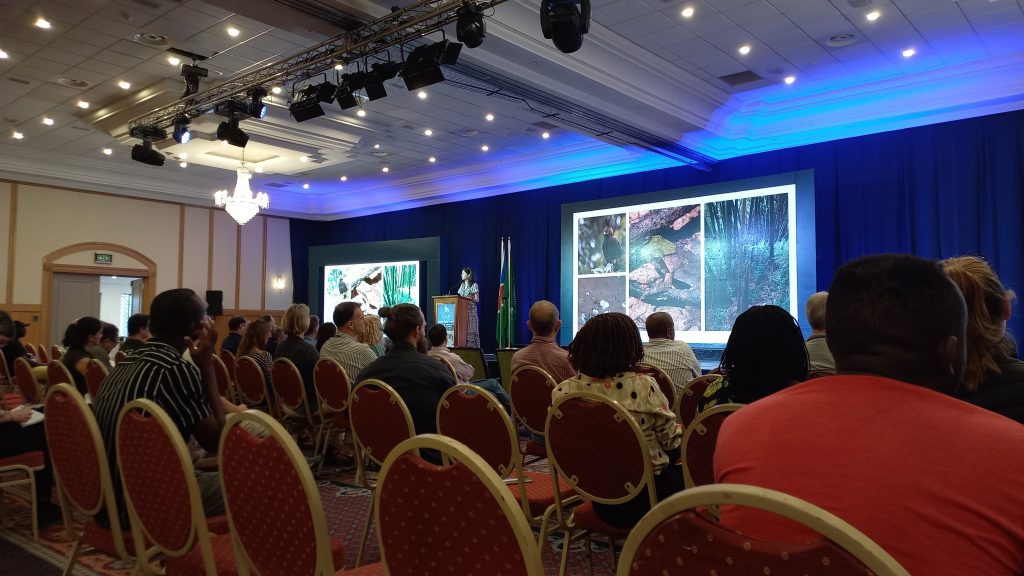Empowering conservation through technology
Newton Simiyu, Saving Meru’s Giants Programme Manager and devoted to elephant and giraffe conservation, explains how technology has a mammoth positive impact.

Newton Simiyu, attending the SMART Global Congress 2024
Technology has long been pivotal to conservation efforts. From monitoring animal populations using radio collars or camera traps (a camera triggered by motion), to utilising UAVs (unmanned aerial vehicles) and satellites to monitor habitat degradation and incidents of illegal activity such as poaching, technology is increasingly central to ensuring conservation efforts are prioritised and implemented to have maximum impact.
Between the 10th and the 14th of March, I was in Windhoek, Namibia for the inaugural SMART Global Congress, with the theme: ‘Empowering Conservation through Technology’. The Global Congress attracted a worldwide attendance with over 300 SMART practitioners coming from over 55 different countries across the globe.
What is SMART?
SMART stands for: Spatial Monitoring and Reporting Tool. It is a platform for a range of tools and software to help conservationists monitor and protect species and habitats. Developed in 2011 by a partnership of conservation organisations including the World Wildlife Fund and the Zoological Society of London, SMART has been revolutionary in allowing conservationists to collect, visualise, analyse, and act on field data. Their approach focuses on three main areas: 1) Cutting-edge technology; 2) Building conservation capacity; 3) Empowerment of SMART conservation practitioners. They allow practitioners to make data-driven decisions, enabling conservation resources to be allocated most effectively, thus achieving the maximum impact.
All the participants were eager to learn and share knowledge around the conference theme. The conversation revolved around leveraging technology to enhance conservation efforts worldwide.
Data is core to all conservation efforts; hence the need to get it right. Accurate and reliable data ensures robust findings and analysis, which in turn leads to relevant policies, interventions, and regulations – and more positive impact for wildlife. Participants at the conference recommended that all conservation organisations should embrace data-driven approaches. By leveraging SMART, we can allow data to really drive our work, as we track wildlife populations, detect threats, and adapt strategies in real time.
The discussions not only covered topics including the application of innovative tools and ‘data-driven’ strategies in conservation, but also explored collaborative approaches to how we can use technology to safeguard the planet.
Technological tools and platforms were not only discussed during the conference, but also launched. One platform, called The Gundi platform, emerged as a potential game-changer. The most powerful feature of this platform is that you can use it to seamlessly connect data from any technology – be it from camera traps or GPS collars – on one integrated platform and convert the data into a useable format with ease. This allows for real-time analysis and rapid decision-making, whether it is tracking animal movements or monitoring poaching incidents.
The diverse gathering at conferences such as this exciting opportunity in Windhoek, fosters knowledge exchange, presenting Born Free an opportunity to learn from successful conservation initiatives worldwide and allowing us to adopt best practices in our conservation work, thus having a direct positive impact on wildlife conservation.

Presentation at the SMART Global Congress 2024
Developments in advanced monitoring techniques, including real-time data, will enable a swift response to emerging threats. Experiences shared by experts at the conference can be integrated into training programmes to enhance the skills of field staff and build their capacity to effectively use technologies in the field.
Born Free, being a leader in the wildlife conservation space, aims to partner with like-minded organisations to better integrate technology into our conservation programmes, and achieve maximum impact for people and wildlife. We have recently partnered with Save the Elephants, who use GPS collars to track the movement of elephants. We hope this collaboration and use of technology will enable us to make more informed conservation decisions to best protect elephant populations in Kenya.
Also, one of the key emerging yet mostly overlooked issue was that conservation efforts extend beyond technology. Ensuring rangers have proper, practical gear – like sturdy boots and water bottles – is crucial for effective on-the-ground conservation. This, we must not forget!
As a conservationist, the person I arrived as at Windhoek as is not the person I came out as. I gained invaluable lessons which will positively impact me going forward. I have been inspired to redouble my efforts in conservation and technology.
One of the key lessons I took away from the conference was that ‘collective actions can make a difference for wildlife’. The importance of collaboration across borders cannot be understated. Conservation challenges are interconnected, and solutions require joint efforts.
As the sun set over Windhoek, we all felt that history had been made at the SMART Global Congress, leaving an indelible mark on all of us. The Congress rekindled hope in and united us as conservationists, regardless of where we all came from; all speaking with one voice and with our resolve strengthened “to protect our planet’s natural heritage”.
As we embrace technology and collaboration, we pave the way for a brighter future for wildlife and their habitats.
